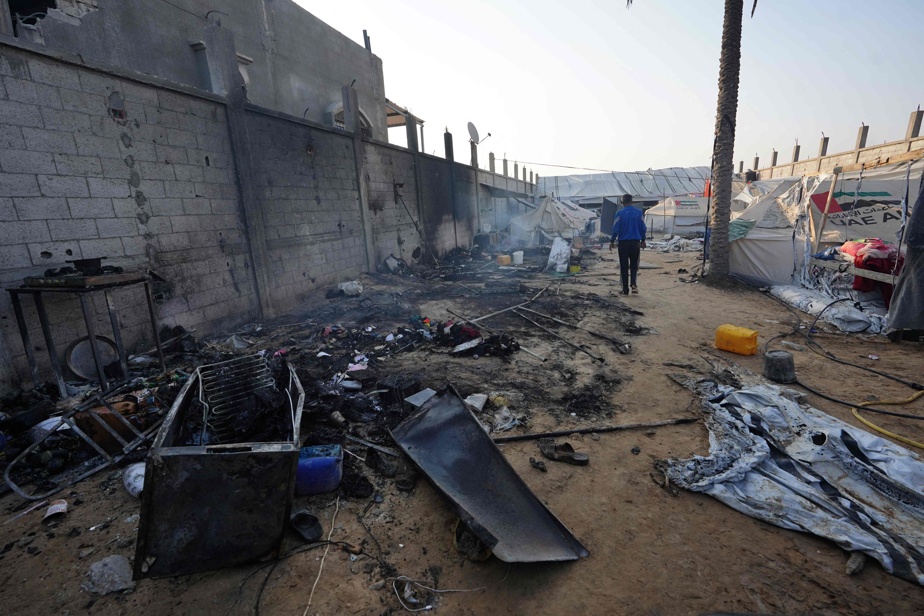Twenty-two people were killed and 45 others injured in shootings near an office of the International Committee of the Red Cross (ICRC) in the Gaza Strip, where fighting between the Israeli army and the Palestinian movement Hamas is continuing. continue on Saturday.
Exchanges of fire broke out early Saturday between Palestinian fighters and Israeli forces in the northern city of Gaza, according to an AFP journalist. In the Zeitoun neighborhood, witnesses saw Israeli helicopters firing on Palestinian fighters.

PHOTO AYMAN AL HASSI, REUTERS
Palestinians search for victims in a building destroyed by Israeli strikes in Gaza City on June 22.
The army said on Saturday that its troops had “eliminated” “several terrorists” the day before in the center of the Gaza Strip and the Rafah region in the south.
Also on Friday, the army exchanged new cross-border fire with Lebanese Hezbollah, an ally of Hamas, a sign of heightened tensions on the Israeli-Lebanese border, which raise fears of an extension of the conflict.
In the south of the besieged Palestinian territory, “large caliber” shots caused “a massive influx of victims to the Red Cross field hospital” on Friday evening, located near its office and which “received 22 dead and 45 injured,” said the ICRC, without specifying the origin of the strikes.
“Humanitarian zone”
The Ministry of Health of the government of Gaza, a territory ruled by Hamas, accused Israel of having “targeted the tents of displaced civilians in Al-Mawasi”, reporting 25 dead and 50 injured.
The coastal area of Al-Mawasi, near Rafah, is home to displaced people driven out by fighting in the rest of the Palestinian territory. It had been declared a “humanitarian zone” by Israel, in theory safe for the displaced.
An Israeli army spokesperson told AFP that “an initial investigation suggests that there is no indication that a strike was carried out” by the army in Al-Mawasi.
Sitting on a stone, a Palestinian woman cries on Saturday in front of the body of a relative wrapped in a white tarpaulin, killed in these shots.

PHOTO BASHAR TALEB, AGENCE FRANCE-PRESSE
A woman sits next to the remains of a relative for burial, killed the day before during a strike in the Al-Mawasi region on June 22.
Men carry the body of another victim on a stretcher, while walls blackened by flames stand behind them.
Smoke still escapes from the ashes in a patch of land reduced to a field of charred debris.
“No safe place”
The war in Gaza was triggered by a bloody attack by the Palestinian Islamist movement Hamas on October 7 on Israel, resulting in the death of 1,194 people, mostly civilians, according to an AFP count based on official data. Of the 251 people kidnapped that day, 116 are still being held in Gaza, 41 of whom are dead according to the army.
In response, Israel promised to annihilate Hamas, in power in Gaza since 2007 and classified as a terrorist organization by the United States and the European Union in particular. His army then launched an all-out offensive in Gaza, which has so far left 37,551 dead, mainly civilians, according to data from the Hamas government’s Health Ministry.
This offensive caused a humanitarian disaster: the population, deprived of everything, survives in extremely difficult conditions, surrounded by hermetically closed borders. International aid, essential to meet the immense needs of the population, is having difficulty arriving, deplores the World Health Organization (WHO).

PHOTO AYMAN AL HASSI, REUTERS
Palestinians search for victims at the site of Israeli strikes in Gaza City on June 22.
A daily break announced recently by Israel on a southern route, presented as a way to facilitate the entry of aid through the Israeli Kerem Shalom crossing into Gaza, had “no impact”, according to the WHO. The entry of aid “has been minimal” and collecting it at Kerem Shalom is dangerous.
In the small Palestinian territory where some 2.4 million Palestinians are crowded together, “more than a million people are constantly on the move” in the hope of finding a safe place while “no place is safe” , declared the Dr Thanos Gargavanis, head of emergencies at WHO.
Cross-border violence
While negotiations for a ceasefire are stalling, the war in Gaza has caused an outbreak of violence on the Israeli-Lebanese border, where confrontations are almost daily. Exchanges of fire between the army and Hezbollah, a movement armed and financed by Iran, have intensified recently.
In a televised address, Hezbollah leader Hassan Nasrallah warned Wednesday that “no place” in Israel would be spared from his movement’s missiles, after the Israeli army announced that “operational plans for an offensive in Lebanon » had been “validated”.
On Friday, the Shiite movement claimed to have launched explosive drones at a military position on Israel’s northern border and carried out rocket and drone attacks against other border military targets. In Lebanon, media reported Israeli strikes and bombings against several locations in the south of the country.
Lebanon must not become “another Gaza”, pleaded UN boss Antonio Guterres, highlighting fears of a regional conflagration.
US Secretary of State Antony Blinken called for “avoiding further escalation in Lebanon”.
